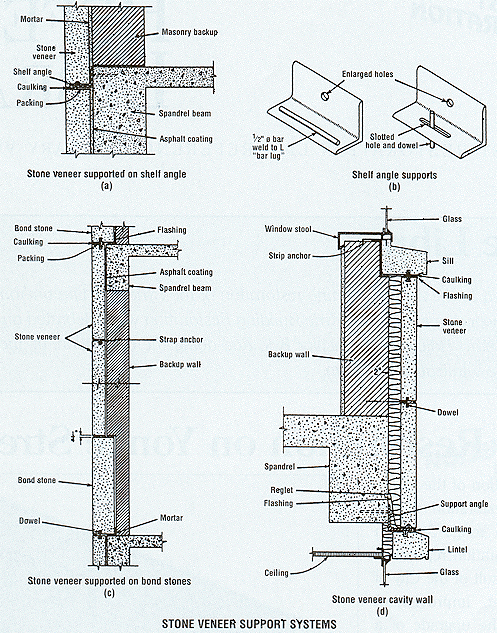Stone varies in weight with the type and density of the material. A rough figure to work with in many instances where stone cladding has been used is: 1 cubic foot ~ 150 pounds. It does not take a lot of stone before weight becomes a consideration important in its own right. A typical tower of scaffold, for example, will have to be specially engineered to address the loading issues. A section of scaffold at ground level is often rated at 5000 pounds, less higher up.
Buildings clad with coursed veneer (the use of veneer stones of the same height forming a continuous course) will have a backup structural wall, similar to brick veneer walls. The thickness of the stone units may vary: 5″ to 6″ is typical but greater thicknesses are often encountered. The stone may be supported on bondstones (also called headers) which rest upon spandrel beams (exterior concrete or steel beams extending from column to column). The bondstone is thicker and will support the weight of several courses of cladding.
Alternatively, shelf angles bolted to the spandrel beam may be used to support the vertical load. Bondstones or shelf angles typically are placed at each floor level. Bond stones can be very heavy and difficult to move given their increased thickness. Shelf angles may have slotted holes with dowels penetrating them and set into the stone bedding surfaces to restrict horizontal movement. Another system is 1/2″ 0 bar (bar lug) welded to the shelf angle surface upon which the stone sits (L) to prevent horizontal movement. The stone has a groove cut in it at the bottom to accommodate the lug.
Interim stone units will be connected one to the other with dowels, set in holes in the stone bottoms and tops. These dowels will be welded to strap anchors which, in turn, are bolted, or otherwise secured, to the backup wall. Thus the whole veneer system is secured vertically and horizontally. The joints are filled with mortar to prevent the ingress of water and hold the stones apart for the absorption of movement, expansion and contraction.
Periodically, the veneer anchoring system needs to be replaced due to fatigue, rust or other forms of deterioration. The stone itself might have cracked or deteriorated through some means. After a proper assessment has been completed and a solution proposed, at some point some of the stones will be removed and replaced in a restoration project. Understanding the anchoring system is essential in minimizing damage to the stone or lost production time. It is better to allow a budget amount to have a small section of wall opened up to make the correct determinations before putting your project out for tender. Such preliminary investigations will save everyone time and money.


No Comments